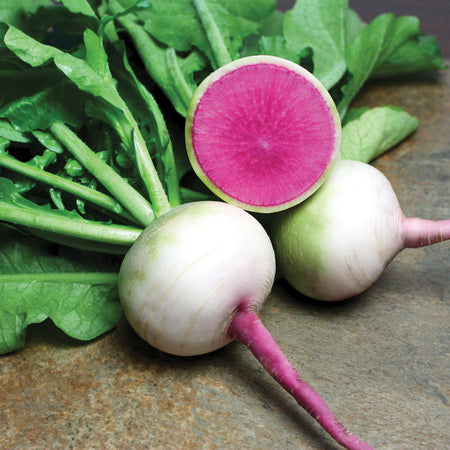STARBURST
Product Description:
| Soil Temp for Germ | 45–80°F |
| Seed Depth | ½" |
| Seed Spacing | ½" |
| Days to Emergence | 4–11 |
| Thin Plants to | 1–2" |
| Row Spacing | 8–12" |
| Fertilizer Needs | Low |
| Minimum Germination | 80% |
| Seeds per Gram | ≈ 80 |
| Seed Life | 4 years |
Raphanus sativus Radishes are best sown in spring or late summer, maturing when days are shorter, sunlight weaker, and temperatures milder; though some varieties are better able to handle summer conditions. The mildly spicy roots, low in calories and rich in fiber and cancer-fighting antioxidants, have good qualities as a digestive tonic or to clear the sinuses and ease sore throats. Anti-microbial properties made them a detoxifier in traditional medicine, and couple with high vitamin C for an immune boost. Don't discard the tops, as they are even denser with nutrients.
Days to maturity are calculated from date of direct seeding.
Culture
• Prepare the bed by working compost into the top 2-3 inches of soil
• Needs consistent soil moisture due to shallow root systems
• Dry or crowded conditions will slow growth and make roots hot or pithy
• The season may be extended from February through October by sowing in cold frames or using row covers
• For extended harvests plant every two weeks
Direct Sowing
• Direct sow spring through early summer
• Three grams will sow 7-8 row feet
• It is essential to thin promptly when they form 2 true leaves
• Sow mid-August—mid-September for a fall crop
Insects & Diseases
• Common insects: See Brassica Insect Information below
• Disease prevention: 5-7 year crop rotation
Harvest & Storage
• Harvest while still young (before splitting)
• Remove tops before storing
• Let a few plants bolt and make a seed pod — green pods have a crunchy, mild radish flavor
• Store at 36°F and 100% relative humidity
What is seed tape?
Seed tapes are perfectly straight rows of precisely spaced crops. No more having to thin seedlings! This biodegradable tape will plant a row 5 meters (16 feet, 5 inches) long. Simply lay it in a furrow and cover with a light layer of sifted compost or soil, water and wait. Save yourself a heap of planting time with these popular vegetable and herb staples.
Brassica Insect Information
Aphids: Control aphids with ladybugs or a hard spray of water or Pyrethrin. Also, select varieties that mature later in the season when aphid populations decline.
Cabbage worms, loopers, and root maggots: The first sign of cabbage worms will be off-white butterflies fluttering near the plants. They lay their yellowish-colored eggs on the undersides of leaves, which hatch into caterpillars that can cause severe root and head damage. To control light infestations, spray plants with Bacillus thuringiensis (B.t.). For heavy infestations, bait cabbage worms by mixing wheat bran into a B.t. solution. Add 1 tablespoon of molasses. Broadcast the bran mixture around the base of plants. Reapply as necessary. Using Reemay or Summer Insect Barrier can also provide control.
Flea beetles: Flea beetles chew tiny pinholes in leaves. Early control is essential to minimize the damage. Spray infected plants with Pyrethrin. Using floating row covers such as Summer Insect Barrier can also provide control.
Symphylans: In some areas of the US, symphylans (also known as garden centipede) can severely impede the plant growth of many crops. Only 1/4 inch long, white, and very active, they eat the root hairs of developing plants. Using larger transplants helps reduce damage. Contact your local county extension agent if you suspect you have a problem.


